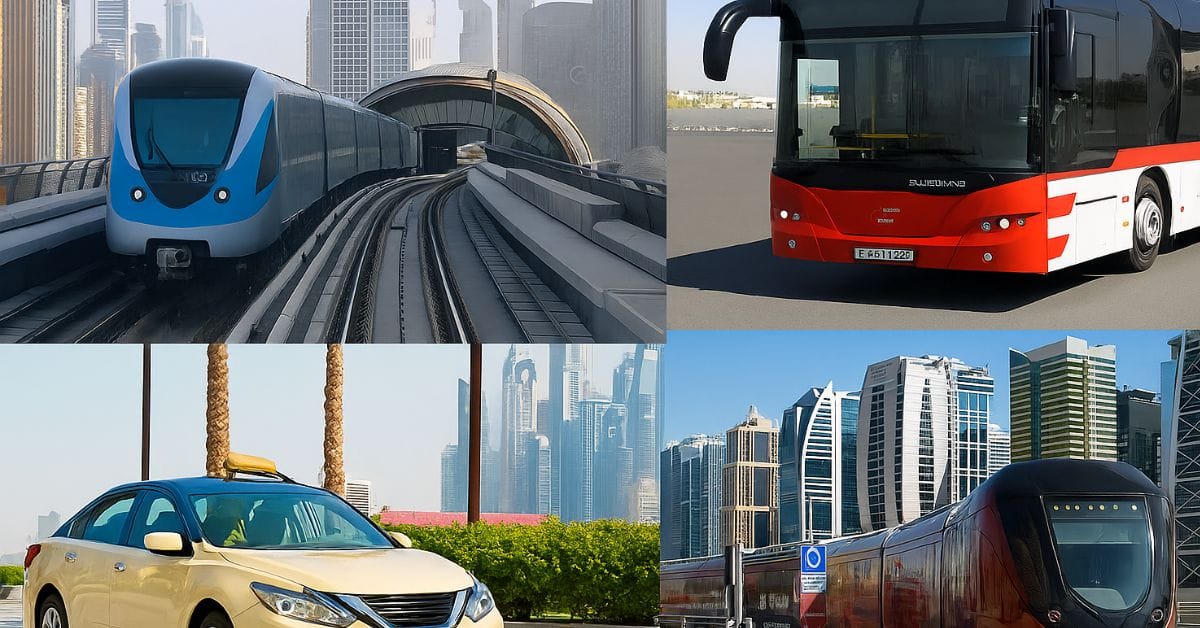Dubai is a city that blends modernity and tradition, with futuristic skyscrapers standing alongside ancient Arabian culture. As a tourist, one of the first things you’ll need to figure out is how to move around the city. With such a wide array of transportation options, navigating Dubai can seem overwhelming at first, but it’s pretty simple once you know your options.
In this guide, we’ll help you explore how to get around Dubai, ensuring you can easily visit the city’s top attractions, from Burj Khalifa to the iconic Palm Jumeirah, using the best modes of transport available. Whether you prefer public transport, taxis, or private rides, this article covers all you need to know.
The Essentials of Dubai Transportation System
Dubai boasts a well-connected and organized public transport system that caters to tourists and residents alike. The city’s transportation is overseen by the Roads and Transport Authority (RTA), which manages an integrated network that includes the Dubai Metro, buses, trams, and water transport services. As a tourist, understanding these modes of transport will help you make the most of your time in the city.
Dubai Metro Guide: Quick and Simple
The metro is a favorite for visitors exploring Dubai for the first time. As one of the world’s safest and cleanest driverless metro systems, it’s modern, fast, and cost-effective for tourists on any budget. The network is made up of two main lines — the Red Line and the Green Line — which cover most of the city’s key attractions.
The Red Line runs from Rashidiya, near the airport, to UAE Exchange in the west. Along the way, it stops at famous spots like the Burj Khalifa, Dubai Mall, Dubai Marina, and Mall of the Emirates. If you’re staying at a hotel in Downtown Dubai or around Sheikh Zayed Road, you’ll likely rely on this line the most.
The Green Line is ideal if you plan to explore the historic side of the city, including the souks, Dubai Creek, and the Al Fahidi district. It connects with the Red Line at two major transfer stations: Union and BurJuman, making the transition between both lines smooth.
Trains are punctual and arrive every few minutes during peak hours. Stations are easy to navigate, with signs in both Arabic and English, numerous ticket machines, and staff available to assist you in topping up your Nol Card. Air-conditioning inside the trains and stations keeps you cool during the city’s hot months.
A bonus: the metro gives you views of the skyline as you ride along the elevated tracks, especially when approaching the Palm Jumeirah or the Marina. It’s one of the most convenient ways to skip traffic jams and reach your destination quickly.
Riding the Dubai Tram System
The Dubai tram system is the perfect add-on to the metro. Opened in 2014, the tram line loops through key parts of the city’s coastline and residential areas. It primarily serves the busy neighborhoods around Dubai Marina, Jumeirah Beach Residences (JBR), Al Sufouh, and the Palm Jumeirah, with a monorail connection.
Trams run every 8 to 10 minutes, making short trips easy, whether you’re heading to the beach, a café, or a waterfront promenade. Stations are clean, well-marked, and designed with shaded areas to protect you from the sun while waiting.
One of the biggest perks is how smoothly the tram links to other parts of the Dubai public transport network. For instance, the tram connects directly with the metro at the Jumeirah Lakes Towers (JLT) and Dubai Marina stations. Many visitors use the tram for its scenic route too — riding along the coastline gives you lovely views of high-rise towers, luxury hotels, and bustling beach spots.
Like the metro, you’ll need your Nol Card to ride the tram, and you can top it up at tram stations or nearby metro stops.
Using the Dubai Bus Routes
For travelers who want to reach every corner of Dubai without spending too much, the city’s bus network is a wise choice. More than 1,500 buses run daily across clearly marked Dubai bus routes, connecting major tourist areas, residential communities, shopping hubs, and business districts.
Buses are clean, air-conditioned, and run on time. Routes reach places that the metro doesn’t cover, such as parts of Deira, Satwa, or outlying suburbs. Tourists often use buses to reach local beaches or community markets that sit beyond the metro’s reach.
Each bus features clear route maps displayed inside and at the stops, along with announcements in both English and Arabic. Stops are spread out every few hundred meters in busy areas, so you won’t have to walk far.
Most buses operate from early morning until late at night, and on weekends, some lines run 24 hours a day. Payment is simple, just tap your NOL card when boarding and exiting. It’s an affordable way to see the city like a local.
Dubai Taxis for Tourists
If you prefer door-to-door comfort, Dubai taxis for tourists are everywhere and ready to take you to your hotel, a shopping mall, or even straight to the desert edges for an adventure. These taxis are managed by the RTA, which ensures fares are fair, cars are clean, and regulations are in place.
Look out for the cream-colored cabs, or the special pink-roof taxis driven by female drivers for women and families who prefer this option. Taxis can be flagged on the street, booked via the RTA Dubai app, or picked up at official taxi ranks at shopping centers, hotels, and Dubai International Airport.
All cabs use meters, so you don’t need to worry about bargaining. Base fares vary slightly depending on the time and pick-up point; rides from the airport incur an additional surcharge. Drivers accept cash and cards, but having small change is always a good idea.
For short hops around the city or late-night returns to your hotel, taxis are the quickest choice, especially if your destination is not near a metro or bus station.
Ride-Hailing Dubai (Uber, Careem)
In recent years, ride-hailing services in Dubai (Uber, Careem) have become very popular with tourists. These apps are convenient if you don’t want to wait for a taxi or walk to a stand. Booking through Uber or Careem means you can choose your pick-up point, track your driver in real time, and see your fare before you ride.
You’ll find a range of cars to match your budget — from everyday sedans to more premium vehicles for longer drives or special occasions. Many visitors rely on these services for late-night trips back from restaurants or nightlife areas, such as the Marina or Downtown.
Both Uber and Careem operate across the city and are available 24/7. Payment is cashless and smooth — just link your credit card to the app. Drivers usually know the best routes and speak English, which makes communication easy.
Exploring by Water: Ferries, Abras, and Water Taxis
Dubai’s location on the coast and its winding creek make water transport a special part of getting around. For visitors who want to see the city from a different angle, taking a ferry, abra, or water taxi is a great idea.
Water taxis are like private boats for short or long rides along the shore or across Dubai Creek. They are clean, safe, and run by the RTA. You can book them in advance for a scenic ride between areas like the Palm Jumeirah, Dubai Marina, and older districts.
Abras are the city’s traditional wooden boats. A short abra trip across the creek is inexpensive and offers a glimpse into Dubai’s history. Sit side by side with locals as they cross between Deira and Bur Dubai. No visit is complete without this classic ride.
Dubai Ferry services run modern boats along the coastline. Popular ferry routes pass by places like the Burj Al Arab, Atlantis The Palm, and the stunning skyline near Jumeirah Beach. It’s a relaxed way to see the city’s best sights from the water without spending too much.
Smart Payment: Cards, Apps, and Routes
Using Dubai’s transport is simple when you know how to pay and plan. Here’s how to make it hassle-free:
- Get a Nol Card: Buy it at any metro station, bus terminal, or convenience store. Load money once — use it for the Dubai Metro, Dubai tram system, Dubai bus routes, and some water taxis or ferries.
- Top Up Anywhere: Add credit at metro stations, Nol Card kiosks, supermarkets, or even some bus stops.
- Check Your Balance: Use the machines at stations or ask an attendant if you’re unsure how much is left.
- Use the RTA App: Download the official RTA Dubai app. It shows live metro and bus times, fares, maps, and parking options if you’re renting a car.
- Plan with Google Maps: Many travelers also rely on Google Maps for real-time routes and travel times — perfect for checking the quickest way to reach the Palm, Marina, or the airport.
- Know Your Routes: Keep an eye on station maps and signs so you don’t miss transfers between metro, tram, or bus.
A little prep means no stress, just tap, ride, and enjoy the city.
Best Ways to Travel for a Day Trip Around Dubai
If you’re planning to see the best of Dubai in a day, mixing and matching transportation options can be the most efficient way to explore the city. For example, take the Dubai Metro to visit popular landmarks like the Dubai Mall and Burj Khalifa, then hop on a taxi to visit Dubai Marina or the Palm Jumeirah.
- Morning: Start your day with the metro to get to downtown Dubai. Visit the Dubai Mall and Burj Khalifa, then grab a tram to head over to Jumeirah Beach.
- Afternoon: After lunch, take a water taxi or ferry to see the coastline. If you’re interested in the historical side of Dubai, take an abra ride across Dubai Creek.
- Evening: Conclude your day with a leisurely dinner by the water at the Dubai Marina or a shopping spree at the Mall of the Emirates.
By using a combination of metro, tram, bus, water taxis, and ride-hailing services, you can easily see the best parts of Dubai, no matter how little time you have.
Final Tips for Tourists: Making the Most of Public Transport in Dubai
Before you set off on your adventures across Dubai, here are some essential tips to help you make the most of the city’s transport system:
- Avoid peak hours: Traffic can be heavy during the morning and evening rush hours. Plan your trips around these times to avoid crowds and delays.
- Use the Nol Card: It’s the best way to pay for your metro, tram, bus, and water transport rides. It’s simple, quick, and can be easily topped up.
- Know the routes: Be sure to check timetables, routes, and station maps in advance, especially if you’re traveling to more remote locations.
- Plan for the heat: During the summer months, temperatures in Dubai can reach incredibly high levels. Ensure your transportation options are air-conditioned, and stay hydrated.
Wrapping Up
Navigating Dubai is relatively simple, with an extensive range of transport options to suit every kind of traveler. Whether you’re using the fast and efficient Dubai Metro, the scenic Dubai Tram, or even booking a ride through Uber or Careem, getting around the city is easy and enjoyable. Depending on your preferences, budget, and itinerary, you’ll find the ideal mode of transport to help you explore Dubai to its fullest.
With the combination of modern public transit and unique experiences, such as water taxis and desert safaris, Dubai offers a rich and diverse set of transportation options that make exploring this incredible city easier than ever.
Frequently Asked Questions
1. What is the best way to pay for public transport in Dubai?
The easiest way is to get a Nol Card. Top it up once and use it on the Dubai Metro, buses, trams, and some water transport.
2. Is it better to use taxis or ride-hailing apps in Dubai?
Both are reliable. Dubai taxis for tourists are easy to find and metered, but many visitors prefer ride-hailing like Uber or Careem for upfront fares and convenience.
3. How late does the Dubai Metro run?
The metro runs until midnight on weekdays and later on weekends. Always check the latest schedule on the RTA app or station signs.
4. Can tourists use buses to reach beaches and markets?
Yes! The Dubai bus routes connect beaches, markets, and neighborhoods that the metro doesn’t reach. Buses are air-conditioned, safe, and budget-friendly.
5. Do I need an international driver’s license to rent a car in Dubai?
Most tourists do need an international driver’s license, along with a valid passport and credit card. It’s the best option for trips to the desert or places outside the metro and bus network.





